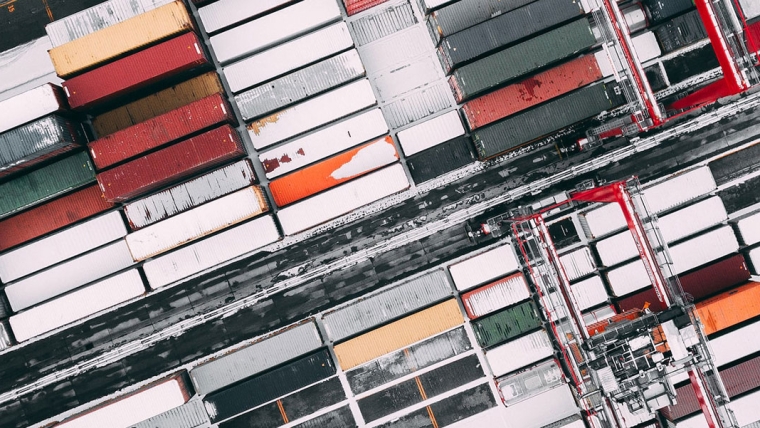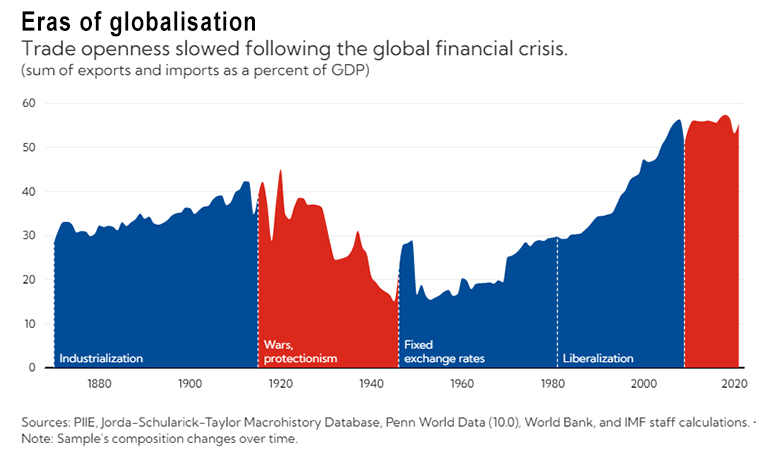
By Shekhar Aiyar and Anna Illyina
The free flow of ideas, people, goods, services, and capital across national borders leads to greater economic integration. But globalisation, the trend toward these things moving ever more freely between nations, has seen ebbs and flows over the decades.
Those trends are coming into sharper focus this year as policymakers work to understand and address the prospect of geoeconomic fragmentation, which threatens to undo the integration that has improved the lives and livelihoods of billions of people.
Looking back over a century and a half of data, the main phases of globalisation are clearly visible using the trade openness metric—the sum of exports and imports of all economies relative to global gross domestic product.
As the Chart of the Week shows, globalisation plateaued in the decade and a half since the global financial crisis. This latest era is often referred to as “slowbalisation.”

Each of the chart’s five main periods was characterised by different configurations of economic and financial powers, and different rules and mechanisms for economic and financial ties between countries, as we recently highlighted in a recent IMF staff note that discussed the impact of trade fragmentation as well as technological decoupling.
- The Industrialisation era was a period when global trade—dominated by Argentina, Australia, Canada, Europe, and the United States—was facilitated by the gold standard. It was largely driven by transportation advances that lowered trade costs and boosted trade volumes.
- The Interwar era saw a dramatic reversal of globalisation due to international conflicts and the rise of protectionism. Despite the League of Nations push for multilateral cooperation, trade became regionalised amid trade barriers and the breakdown of the gold standard into currency blocs.
- The Bretton Woods era saw the United States emerge as the dominant economic power with the dollar, then pegged to gold, underpinning a system with other exchange rates pegged to the greenback. The post-war recovery and trade liberalisation spurred rapid expansion in Europe, Japan, and developing economies, and many countries relaxed capital controls. But expansionary US fiscal and monetary policy driven by social and military spending ultimately made the system unsustainable. The United States ended dollar-gold convertibility in the early 1970s, and many countries switched to floating exchange rates.
- The Liberalisation era saw gradual removal of trade barriers in China and other large emerging market economies and unprecedented international economic cooperation, including the integration of the former Soviet bloc. Liberalisation accounted for most of the increase in trade, and the World Trade Organisation, established in 1995, became a new multilateral overseer of trade agreements, negotiations and dispute settlement. Cross-border capital flows surged, increasing the complexity and interconnectedness of the global financial system.
- The “Slowbalisation” that followed the global financial crisis has been characterised by a prolonged slowdown in the pace of trade reform, and weakening political support for open trade amid rising geopolitical tensions.
Shekhar Aiyar is the IMF's Mission Chief for Germany. Anna Ilyina is Assistant Director in the Strategy, Policy and Review Department (SPR) of the IMF. This is a re-post of an article that ran on the IMF blog.

We welcome your comments below. If you are not already registered, please register to comment
Remember we welcome robust, respectful and insightful debate. We don't welcome abusive or defamatory comments and will de-register those repeatedly making such comments. Our current comment policy is here.